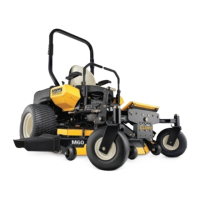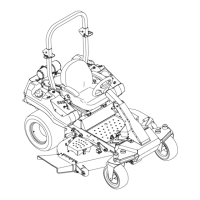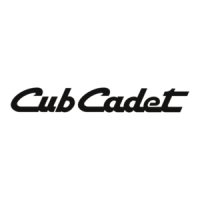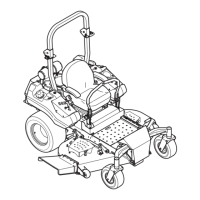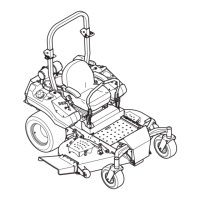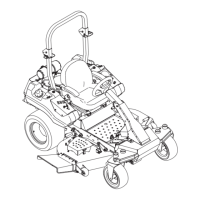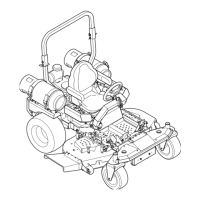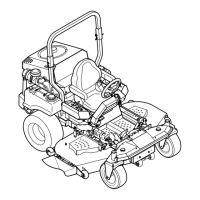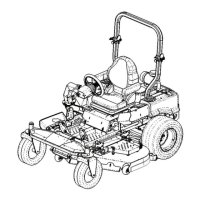30 se c t i O n 6— Ma i n t e n a n c e & ad j u s t M e n t s
As a further precaution, only charge the battery in a well
ventilated area.
Always shield eyes and protect skin and clothing when
working near batteries.
gases. Use extreme caution when handling batteries. Keep
batteries out of the reach of children.
Battery Maintenance
The battery is filled with battery acid and then sealed at
fill caps and check the level of the liquid electrolyte in the
battery. If the level in any of the six cells has dropped below
the bottom of the split ring inside the fill hole, refill the cell
with distilled water.
terminal sealer, or coat the terminals with a thin coat of
grease or petroleum jelly, to protect against corrosion.
Always keep the battery cables and terminals clean and
free of corrosion.
Avoid tipping. Even a sealed battery will leak electrolyte
when tipped.
WARNING!
emit explosive gases. Use extreme caution when
handling batteries. Keep batteries out of the reach
of children.
Tire Maintenance
Check the tire air pressure before each use. Inflation pressure
of the rear tires is important for stability while the mower is in
operation. If the tire diameter is not equal between the two tires,
the mower will pull to one side. Keep the tires inflated to the
recommended pressures. Improper inflation will shorten the tire
Do not inflate a tire above the maximum pressure shown
on the sidewall of the tire.
Do not reinflate a tire that has been run flat or seriously
service the tire.
maintain straight travel (see tire side wall for proper
inflation pressure).
Keep the valve caps tightened to prevent air pressure loss.
Inflation Pressure:
Leaking Tires
When a flat tire occurs, repair or replace immediately. The normal
procedure is to remove the wheel and replace it. If a tire is
getting soft, park the mower on the nearest level, paved area.
Rear Tire
a.
wheel and jack up the tire that leaks about an inch
off the ground.
Loosen and remove the lug nuts and remove the b.
wheel.
Mount a wheel and tire, replace the lug nuts, and c.
ft-lbs.
Front caster wheel2.
a.
wheel so that the tire is an inch off the ground.
Loosen and remove the locknut from the axle b.
assembly and pull the axle assembly from the caster
yoke. The wheel and two spacer sleeves will drop
free.
c.
yoke, through a spacer sleeve, a wheel, the other
spacer sleeve and finally through the other side of
the caster yoke.
Tighten the locknut on the end of the axle assembly.d.
Lower the mower off the jack and continue mowing. e.
the wheel placed in a large bucket of water. Carefully inspect the
tire, rim and valve for escaping air bubbles which indicate a leak.
Mark each leak with a yellow marking crayon and then deflate
the tire to 8 psi and repeat the inspection. If the leaks you find
are pin hole size to ⁄” diameter, the tire can be repaired. If the
leaks are larger than ⁄” diameter, the tire can be repaired. If the
tire bead is damaged, the tire can be repaired or the tire will have
to be replaced.
Lubrication
Using a pressure lubricating gun, lubricate all grease
fittings and points as noted in the Lubrication Chart.
Lubricate all other pivot points with a quality lubricating oil
Using the Deck Wash System
WARNING! When using the deck wash system,
never engage the deck from any position other than
assistant or engage deck in the presence of any
bystanders.
Complete the following steps after each mowing:
NOTE:
away from people, children, animals, and your house, garage,
parked cars, etc.
Attach the nozzle adapter to a standard garden hose
connected to a water supply.
Move the tractor to an area within reach of the hose where 2.
the dispersal of wet grass clippings is not objectionable to
stop the engine.
